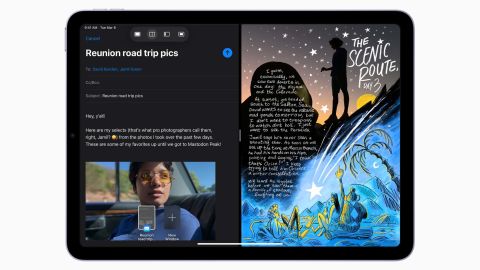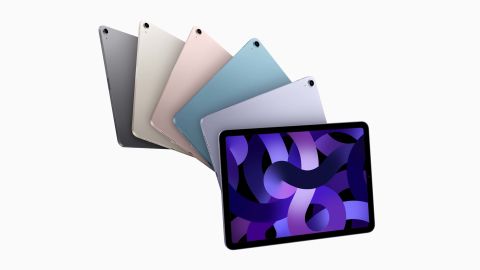Apple’s new iPad Air might look similar to the previous iteration, but the tech giant is now using its powerful M1 chip to help supercharge it. In addition, it’s adding an improved front-facing lens with Center Stage, a feature that helps keep you in the frame on all your video calls.
Here’s what’s new and what’s staying the same.
M1 arrives inside the iPad Air

The iPad Air’s big news is an upgrade to the Apple-made M1 chip — complete with an 8-core CPU, an 8-core GPU and a 12-core Neural Engine. Apple says that will allow a 60% faster experience than the previous-gen iPad Air’s A14 Bionic chip, so it can better handle multitasking, crush creative exports like movies and photo edits in apps and deliver longer battery life. Plus, it supports Apple’s Magic Keyboard, an accessory that combines a full keyboard and trackpad.
If you find yourself using the iPad Air for video edits, large graphical tasks or heavy workload tasks, the upgraded device should help provide more bandwidth. The Apple M1 chip should also stretch the life of this fifth-gen iPad Air.
5G is now on the iPad Air

Whether or not you’re a fan of the adoption and rollout of 5G networks, Apple is now spreading the technology over plenty of its devices. The iPad Air is getting support for Sub-6 5G only. This is the more commonly available standard of 5G in the United States, but it also offers speeds closer to 4G LTE. Missing here is support for mmWave 5G, which is faster and exclusive to the iPad Pro.
Center Stage is finally here. With the ninth-gen iPad, Mini and Pro all sporting an improved front-facing camera, we worried Apple would forget about the Air, but the new iPad Air not only includes a 12-megapixel front-facing camera, but it also comes with the innovative Center Stage software, allowing you to stay in the frame on video calls like FaceTime or Webex.
Screen, design and storage stay the same

Other than the new chip and a better camera, which should be more than just marginal improvements, everything else will stay the same. The iPad Air sticks with the 10.9-inch Liquid Retina display, offering a bright, immersive experience. And while it’s surrounded by thin bezels, the iPad Air keeps the helpful Touch ID built into the power button, which is a fast way to unlock the device or authenticate purchases. Apple is also sticking with two storage sizes to pick from for the iPad Air: 64GB or 256GB.
The design is also staying put, keeping the iPad Air as an ultraportable choice with a lightweight aluminum build. It can easily slide into a backpack, be used in a classroom or packed on a carry-on. It comes in Space Gray, Starlight, pink, purple and blue finishes, but if you’re looking for a better display or a bold new design, you’ll be well served with your current model.
The takeaway
Apple’s fifth-generation iPad Air doesn’t offer a full redesign or monumental change, making it similar to the iPad Pro as Apple continues to update an already well-tested formula. The integration of the M1 chip will likely increase the fluidity and swiftness of iPadOS 15, along with some bigger leaps for more intense tasks, and we’re happy to see Center Stage arrive on the iPad Air as well.
We’ll be putting the latest-gen iPad Air through its paces soon, but if you’re already sold, preorders start on March 11. The iPad Air starts at $599 for a 64GB Wi-Fi model, and cellular starts at $749.
 iPad Air (5th Gen)
|
 iPad Air (4th Gen)
|
|
|---|---|---|
| Display | 10.9-inch Liquid Retina display | 10.9-inch Liquid Retina display |
| Processor | Apple M1 chip | Apple A14 chip |
| Cameras | 12-megapixel wide camera (rear); 12-megapixel ultrawide camera (front) | 12-megapixel wide camera (rear); 7-megapixel wide camera (front) |
| Storage | 64GB/256GB | 64GB/256GB |
| Battery | All-day | All-day |
| Size and weight | 9.74 x 7.02 x 0.24 inches; 1.02 pounds | 9.74 x 7.02 x 0.24 inches; 1.02 pounds |
| Colors | Space Gray, Starlight, pink, purple and blue | Silver, Space Gray, Rose Gold, green and Sky Blue |
| Starting price | $599.99 | $599.99 |
Source: www.cnn.com
